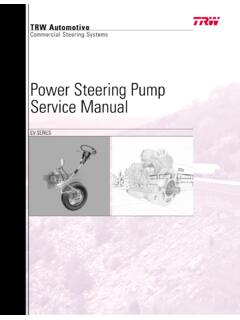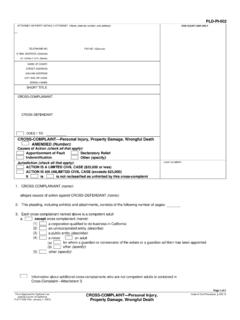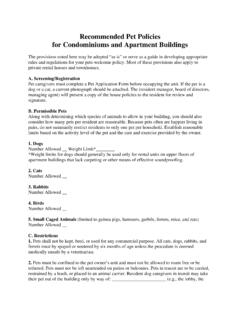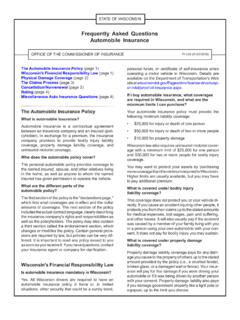Transcription of Steering Diagnostics Service Manual - TRW Aftermarket
1 Steering DiagnosticsService ManualCHART YOUR WAY TO EASY STEERINGTRW AutomotiveCommercial Steering SystemsiThroughout this troubleshooting guide, test procedures are recommended to help locatethe cause of each complaint. While performing these tests, TRW advises that you TAKENECESSARY PRECAUTIONS when working with internal vehicle components and hothydraulic of the tests in this Manual require the use of a PSSA. This device is a combination flow meter, shut-off valve,and pressure gauge. This tool will allow you to measure flow and pressure, and provide a load on the pump throughthe hydraulic lines of the Steering system. This tool is required to correctly analyze a Steering system.
2 TRW recom-mends that you DO NOT BEGIN TROUBLESHOOTING A Steering SYSTEM WITHOUT THE USE OF A PSSA. Ifyou are not sure how to use a PSSA, you may refer to the video available through our website This video compliments the tests in this book which require the use of the guide was prepared for the purpose of providing general advice concerning the diagnosis and correction ofcommercial vehicle Steering related problems. This guide is intended for the use of properly trained, professionalmechanics, NOT "Do-it-Yourselfers". Also, this guide should be used in conjunction with Service manuals provided byboth the vehicle and component manufacturers.
3 Diagnosis and correction of commercial vehicle Steering relatedproblems should only be handled by properly trained, professional mechanics who have the proper equipment, tools,instructions and know-how to perform the work properly and Steering System Analyzer (PSSA) Gauge TRW Inc., 2002A warning describes hazards or unsafe practices which could result insevere personal injury or caution describes hazards or unsafe practices which could result inpersonal injury or product or property note gives key information to make following a procedure easier page intentionally left blankiiiTable of ContentsPreface .. 3 Flow Chart Diagrams.
4 7 Test Procedures .. 19 Comments .. 35 Test Results .. 39ivThis page intentionally left blank1 Section 1 PrefaceIntroduction .. 3 Understanding the ComplaintReading the Flow ChartsWarrantyDefinitions .. 4-5 Hard SteeringReduced WheelcutSteering Wheel KickBinding, Darting, and OversteerDirectional PullRoad Wander/Loose SteeringNon-RecoveryShimmyNoiseExternal LeakageThis page intentionally left blank3 Understanding the ComplaintSteering systems for heavy duty trucks are made up of many components from the Steering wheel to the road purpose of the Steering system is to give the driver directional control of the a driver feels the Steering control over his/her vehicle is not like it should be, it is up to you to determine if thereis a problem, and if so, figure out what is causing it.
5 It is always easier to fix something if you really understand thecomplaint. Some ways you could do this are: Talk to the driver and ask a lot of questions like what, when, where, and how Make sure you can feel or see the problem. Have the driver show you exactly what he/she means. Walk around the truck, looking for anything that may be an obvious cause of the make your job easier and faster this Manual has both the flow charts and test procedures/comments, each in theirown section. Once you have a good understanding of what the complaint is, choose the flow chart that best matchesthe symptoms described to you. Because there are different ways to say the same thing, we have provided ourdefinitions of the 10 most common complaints in this book.
6 Use these to determine which section of the manualwould be helpful to begin diagnosing the Steering the flow charts:Start the chart at the BEGIN box. Follow the lines to the next box answer the question or perform the test to verifythe cause of the complaint, then proceed to the next step. These boxes are arranged in order of likelihood of beingthe cause of the driver's complaint. It is important to complete the tests, in order, and follow the flow of thechart. Locate correct test number in the TEST PROCEDURES section, and follow the test procedure. When you aredone with the test, note the results and correct the root cause. If condition still exists, keep going through the chart (ifnecessary, to correct the problem).
7 The results of some tests will need to be recorded. Use the TEST RESULTS section to record these you identify a problem through a test procedure it is important that you retest the vehicle to make sure the conditionhas been you have identified that a Steering component on your vehicle needs to be replaced, this does not always mean it iswarrantable. Please read your manufacturer s warranty carefully before submitting a Steering component for Hard SteeringHard Steering is when Steering effort at the Steering wheel is more than 200 inch pounds (typically 18-22 lbs atthe rim of the Steering wheel). Steering is still possible, but there is not enough power phrases used: Won t turn Hangs-up Locks-up No assist Shuts-down Won t turn unless moving Turns hard2.
8 Reduced WheelcutCommon phrases used: Too great of turning radius required Wheelcut restricted Not enough turns lock to lock3. Steering Wheel KickSteering Wheel Kick is when the road wheels hit a bump that the Steering wheel reacts to. The kick is usuallydampened out phrases used: Kickback Backlash Bump steer4. Binding, Darting and OversteerBinding is a change or increase in Steering wheel effort. Binding will usually not require the effort levelsdescribed in Hard Steering , unless it is severe. Darting and oversteer are words that mean the driver suddenlygets more turning than he/she Directional PullCommon phrases used: Steering pulls to the right (or left) Truck pulls to the right (or left) A constant force is required to keep the truck going straight56.
9 Road Wander/Loose SteeringCommon phrases used: Lash in Steering Lost motion in Steering Continual corrections are needed at the Steering wheel to keep the vehicle from wandering7. Non-RecoveryCommon phrases used: Wheels don t return to straight ahead8. ShimmyA severe Shimmy condition can be felt at the Steering wheel. Typically once something triggers a Shimmycondition to occur it is sustained until the driver does something (such as slow down) to dampen out phrases used: Shake at Steering wheel9. NoiseCommon phrases used: Steering is noisy Clicking or clunking sound is heard when steering10. External LeakageCommon phrases used: Loss of Steering fluid Continual adding of fluid in reservoir requiredDefinitionsThis page intentionally left blank7 Section 2 Flow Chart DiagramsHard Steering .
10 8 Reduced Wheelcut .. 9 Steering Wheel Kick .. 10 Binding, Darting, and Oversteer .. 11 Directional Pull .. 12 Road Wander/Loose Steering .. 13 Non-Recovery .. 14 Shimmy .. 15 Noise .. 16 External Leakage .. 178 Hard SteeringCall technicalserviceBeginOccurs in onlyone direction?Intermittent loss of powerassist?Cold startonly?1. Power Steering fluid in reservoir2. Tire pressure values (TEST #1)3. Fifth wheel properly greased (TEST #2)4. Vehicle has not been overloadedAir in SystemTEST #9 Internal LeakTEST #7Ye sNoNoYe sNo1. Binding at input side of geara. U-joint rubbing - TEST #17b. Intermediate shaft binding - TEST #192. Firewall boot interference/cab mount drop - TEST #183.










